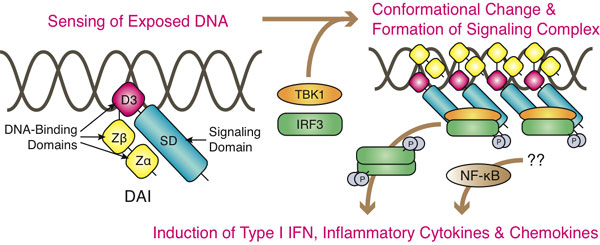Identification and analysis of a cytosolic DNA sensor in the innate immune system
Innate immunity is the first line defense system against invading pathogens. Host cells detect pathogens by a variety of pathogen recognition receptors. These receptors can sense or recognize pathogen-derived molecules called pathogen associated molecular patterns. DNA is one of the known patterns found in bacteria or DNA viruses. Although DNA stimulation evokes powerful innate immune responses in the host cells, the sensors that recognize DNA have not been identified except for Toll-like receptor 9 (TLR9) expressed in endosomes. However, much evidence has suggested that cytosolic DNA exposure provokes the immune responses independently of TLR9.
Recently, we have identified a cytosolic DNA sensor. This receptor recognizes DNA exposed to the cytosol, and then associates with TBK1 kinase and IRF3 transcription factor that are important for type I Interferon (IFN) production. Regarding this function, we named this sensor DAI (DNA-dependent activator of IRFs). We further identified several important domains of DAI, and revealed that DAI forms a multimer upon DNA recognition to activate the down-stream signaling pathways.
By studying DAI and other DNA sensors, we would like to clarify the mechanism of DNA-mediated immune response that is responsible for the exclusion of the invading pathogens but could also lead to autoimmune diseases.
Program member
Tadatsugu Taniguchi (Department of Immunology, Graduate School of Medicine)

DAI senses DNA exposed to the cytosol, associates with TBK1-IRF3, and then activates immune responses.
